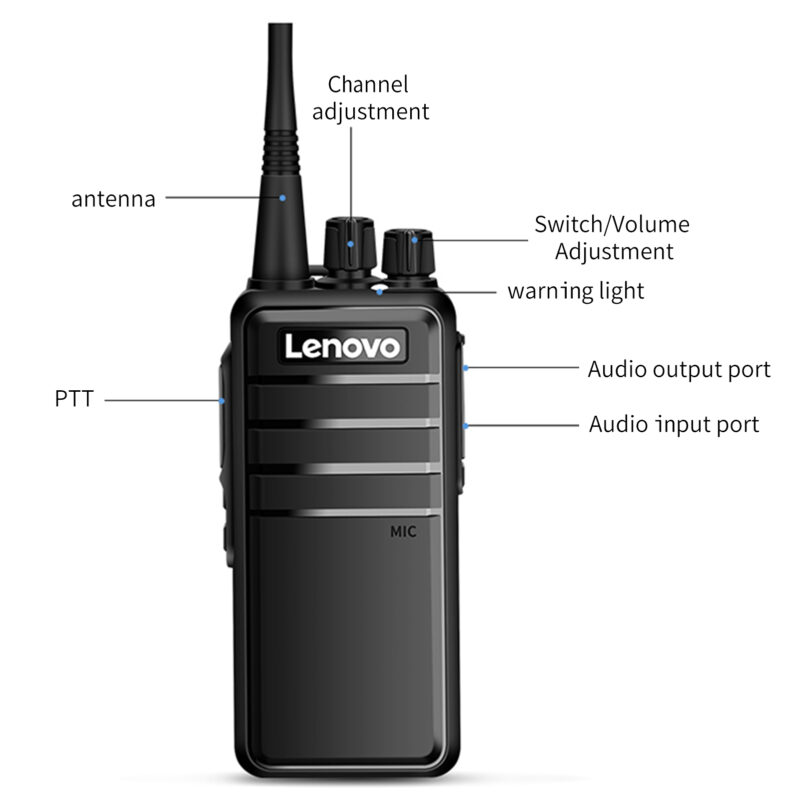How Does a Two Way Radios Work?
A Two Way Radios is a common device facilitating real-time communication across varied channels. Its operation hinges on a push-to-talk button, activating the transmission mode when pressed, enabling message transmission. Releasing the button switches the radio to receive mode, allowing message receipt from other radios. The simplicity of this mechanism ensures swift, direct communication, essential in various professional environments.

IIntroduction to the Button Functions of a Handheld Two-Way Radio —— Lenovo N99
Messages are transmitted via radio waves, traveling through the air from one radio to another. Utilizing diverse frequency bands, Two Way Radios can communicate over long distances, despite limitations from terrain, buildings, and other obstacles. Modern Two Way Radios have technical enhancements, such as digital signal processing and error correction, enhancing communication reliability even in challenging environments.
What’s the Difference Between Two Way Radios and Walkie Talkies?
Despite apparent similarities, Two Way Radios and walkie talkies aren’t synonymous. “Two Way Radios” is a broad term covering a range of communication devices, including walkie talkies. Walkie talkies are compact, handheld, designed for portability and short-range communications.
Conversely, Two Way Radios encompass various devices, often more potent, capable of remote communication. Their versatility extends to fixed installations like vehicles or base stations, suitable for diverse professional scenarios. Inherent differences in function, scope, and application areas underscore the unique characteristics of Two Way Radios and walkie talkies, guiding potential users to make informed decisions based on specific needs.
What is the Working Distance of a Two Way Radios?
The operating range of a Two Way Radios is influenced by several factors, including power output, frequency, and environmental conditions. Higher wattage extends the transmission distance, and the selected frequency band can penetrate obstacles and transmit over greater distances. For example, VHF (Very High Frequency) is suitable for outdoor communications over open terrain, whereas UHF (Ultra High Frequency) performs better in indoor or obstacle-rich urban environments.
Environmental factors like terrain, weather, and buildings may affect radio coverage. For instance, signals travel farther in dry, sunny conditions than in rain or snow. Additionally, advanced technologies like repeaters and digital signal processing can extend the operational range by increasing signal strength or reducing interference.
What is Wattage and Why is it Important?
Wattage refers to the power output of a Two Way Radios, crucial for determining communication range and signal quality. Higher wattage (usually between 4 and 50 watts), extends communication distance and enhances obstacle penetration. However, it also leads to higher battery consumption, requiring frequent recharging or battery replacement.
In contrast, lower-wattage radios, typically 1 to 4 watts, are more energy-efficient but have a shorter range. Therefore, power choice is a trade-off between range and battery life, and should align with the user’s operational requirements. For example, outdoor or emergency response scenarios may necessitate higher-wattage radios, while indoor or short-range communications can be adequately served using lower-wattage radios. This understanding aids in making informed decisions that optimize the balance between communication efficiency and power consumption.
What Frequency Does Two Way Radios Use?
Two Way Radios operate on various frequencies, essential for clear communication. Common frequencies include VHF and UHF, each suitable for different environments. The VHF range is 136-174 MHz and performs well in open areas, whereas the UHF range is 400-512 MHz and is effective in more crowded or urban environments due to its shorter wavelength. Choosing the right frequency is vital for optimal performance and compliance with local regulations. Understanding the differences between these frequencies and assessing the operating environment facilitates better communication, a crucial aspect of effective Two Way Radios use.
What are the Advantages of Two Way Radios Over Cell Phones?
Two Way Radios offer many advantages over cell phones, especially in professional settings. They provide instant communication, vital in emergencies. Unlike mobile phones, they don’t rely on cellular networks, making them more reliable in remote or densely populated areas. The durability and long battery life of Two Way Radios make them a reliable choice for fieldwork. Additionally, they support team communication, enhancing cooperation and coordination. Lastly, Two Way Radios are cost-effective in the long term, with no monthly fees or call charges, making them a practical option for many organizations.
Do I Need a Two Way Radios Permit?
Obtaining a license to operate a Two Way Radios is standard in many countries. The licensing process ensures efficient communication by keeping radio frequencies uncluttered and free from interference. The license specifies the frequencies and channels you’re authorized to use, along with the geographical area of operation. Adhering to these guidelines is crucial to avoid legal issues. Licensing agencies usually have straightforward application and renewal procedures, making compliance relatively easy for individuals and organizations. Additionally, some radios operate on unlicensed channels, although these often have power and range limitations.
Can Two-Way Walkie Talkies from Different Manufacturers Communicate with Each Other?
Compatibility between Two Way Radios from different manufacturers is usually achievable, provided they operate on the same frequency and have compatible channel spacing. However, advanced features or proprietary technology may limit cross-brand communication. Ensuring radios are programmed to the same settings is essential for successful interoperability. Organizations often seek specialized radio technicians’ help to properly configure radios, ensuring seamless communication between different brands. This flexibility in communication is beneficial, especially in collaborative or multi-agency scenarios, leading to a cohesive operating environment.
How Long Do Walkie Talkies Have to be Used Every Day to Use the Charger?
The operation duration of a Two Way Radios before recharging largely depends on battery capacity and usage patterns. Typically, standard Two Way Radios work for about 8 to 12 hours on a single charge. However, frequent use or advanced features may drain the battery quicker. It’s recommended to have a clear understanding of the radio’s battery life, considering the nature of the work and communication requirements. High-capacity batteries or backup batteries are wise choices for extended operation. Some models offer energy-saving features to extend battery life, ensuring Two Way Radios remain operational throughout the workday.
Can Two Way Radios Be Traced?
Yes, Two Way Radios can indeed be traced, especially those equipped with GPS functionality. This feature enables real-time tracking and monitoring, which is essential for ensuring team members’ safety and accountability, especially in challenging or hazardous environments
In addition to location tracking, some advanced radios also offer other tracing capabilities such as call logging and user identification. This data proves invaluable for operational reviews and incident analysis.
However, the level of traceability may vary among different radio models and manufacturers. Therefore, it’s crucial to select radios with tracking features that align with organizational requirements.

